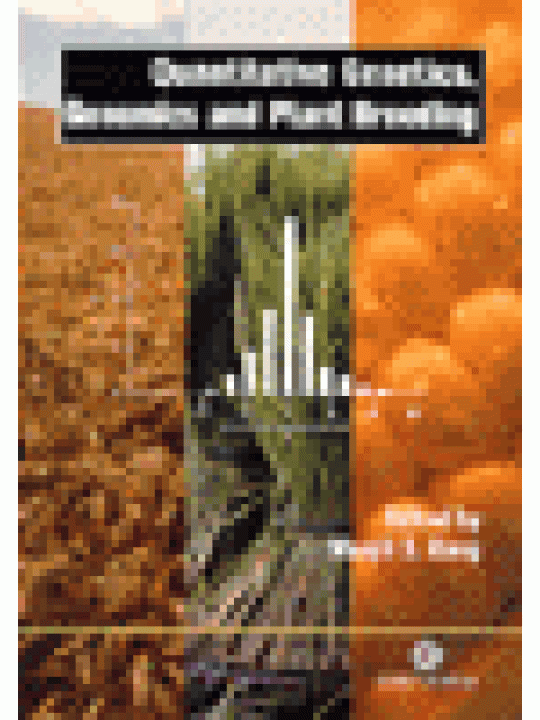Quantitative Genetics, Genomics and Plant Breeding
Edited by M S Kang, Louisiana State University, USA
Pub Date: September 2002
Hardback
432 pages
Readership
Students and professionals involved in plant and crop breeding and genetics, also industry and government agencies
Key Features
• Offers an essential set of review papers for researchers wanting to know what is happening in their field
• Follows the growing realization that quantitative genetics is central to understanding the masses of molecular data that are being generated
• Authors include international authorities from around the world
Main Description
This book provides an overview of the rapidly developing integration and interdependence of quantitative genetics, genomics, bioinformatics and their application to plant breeding. Chapters have been developed from a symposium held in Baton Rouge, Louisiana, in March 2001, although additional contributions have also been commissioned especially for this volume. The main topics covered include: quantitative trait loci (QTL) mapping, genomics, bioinformatics and marker-assisted selection; tissue culture and alien introgression for crop improvement; and advances in genotype by environment interaction/stability analysis.
Reviews
• "The book certainly meets with interest and needs of up to date information of plant breeders, may they be advanced students, practitioners, teachers or researchers." Journal of Phytopathology, March 2003
• "A welcome and timely publication and a stepping stone in a fast-expanding subject area that will play an increasingly important role for the future competitiveness of agricultural research." R Tuberosa, Annals of Botany, 93, 2004
Main Contents
• Vignettes of the history of genetics, G P Redei, University of Missouri, USA
Part I: Genomics, Quantitative Trait Loci, and Tissue Culture
• Quantitative genetics, genomics and the future of plant breeding, B Walsh, University of Arizona, USA
• Why quantitative geneticists should care about bioinformatics, N A Tinker, Agriculture and Agri-Food Canada, Canada
• QTL analysis: problems and (possible) solutions, M J Kearsey, University of Birmingham, UK
• Association mapping in plant populations, J-L Jannink, Iowa State University, USA and B Walsh, University of Arizona, USA
• Integrating molecular techniques into quantitative genetics and plant breeding, J W Dudley, University of Illinois, USA
• Use of molecular markers in plant breeding: drought tolerance improvements in tropical maize, J-M Ribaut, M Banziger, CIMMYT, Mexico, J Betran, Texas A&M University, USA, C Jiang, Monsanto Life Sciences Research Centre, USA, G O Edmeades, Pioneer Hi-Bred Internation Inc, USA, K Dreher, and D Hoisington, CIMMYT, Mexico
• Explorations with barley genome maps, D E Mather, McGill University, Canada
• Global view of QTS/QTLS: rice as a model, Y Xu, RiceTec, Inc, USA
• Marker-assisted backcross breeding: a case-study in genotype building theory, F Hospital, INRA, France
• Complexity, quantitative traits and plant breeding: a role for simulation modelling in the genetic improvement of crops, M Cooper, Pioneer Hi-Bred International Inc, USA, D W Podlich, K P Micallef, University of Queensland, Australia, O S Smith, N M Jensen, Pioneer Hi-Bred International Inc, USA, S C Chapman, CSIRO, Australia, N L Kruger, University of Queensland, Australia
• Linking bio physical and genetic models to integrate physiology, molecular biology and plant breeding, S C Chapman, CSIRO, Australia, G L Hammer, APSRU, Australia, D W Podlich, University of Queensland, Australia and M Cooper, Pioneer Hi-Bred International Inc, USA
• Tissue culture for crop improvement, R H Smith, and S H Park, Texas A&M University Research Park, USA
• Transferring genes from wild species into rice, D S Brar and G S Khush, International Rice Research Institute, The Philippines
Part II: Genotype Environment Interaction and Stability Analysis
• Genotype environment interaction: progress and prospects, M S Kang, Louisiana State University, USA
• Analysing QTL - by environment interaction by factorial regression, with an application to the CIMMYT drought and low-nitrogen stress programme in maize, F A Van Eeuwijk, Wageningen University, The Netherlands, J Crossa, M Vargas and J-M Ribaut, CIMMYT, Mexico
• Elements of genotype - environment interaction: genetic components of the photoperiod response in maize, R Moutiq, Iowa State University, USA, J M Ribaut, CIMMYT, Mexico, G Edmeades, Pioneer Hi-Bred International Inc, USA, M D Krakowsky and M Lee, Iowa State University, USA
• Mechanisms of improved nitrogen use efficiency in cereals, A S Basra and S S Goyal, University of California, USA
• Biplot analysis of multi-environment trial data, W Yan and L A Hunt, Unviersity of Guelph, Canada
• Linear-bilinear models for the analysis of genotype - environment interaction, J Crossa, CIMMYT, Mexico and P L Cornelius, University of Kentucky, USA
• Exploring variety - environment data using random effects AMMI models with adjustments for spatial field trend: Part 1: Theory, A Smith, B Cullis, Wagga Wagga Agricultural University, Australia and R Thompson, IACR Rothamsted, UK
• Exploring variety - environment data using random effects AMMI models with adjustments for spatial field trend: Part 2: Applications, A Smith, B Cullis, D Luckett, Wagga Wagga Agricultural Institute, Australia, G Hollamby, Roseworthy Agricultural College, Australia and R Thompson, IACR-Rothamsted, UK
• Applications of mixed models in plant breeding, M Balzarini, Universidad Nacionale de Cordoba, Argentina
• Defining adaptation strategies and yield stability targets in breeding programmes, P Annicchiarico, Instituto Sperimentale per le Colture Foraggere, Italy

